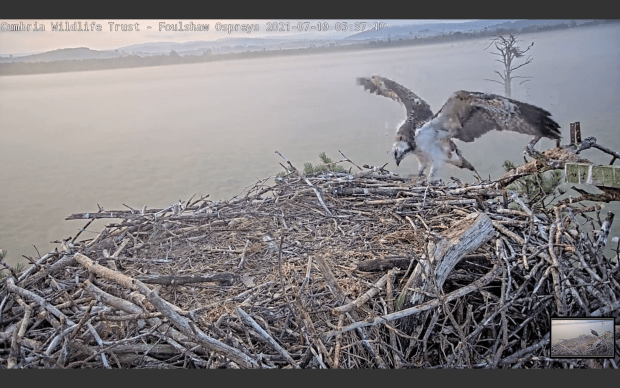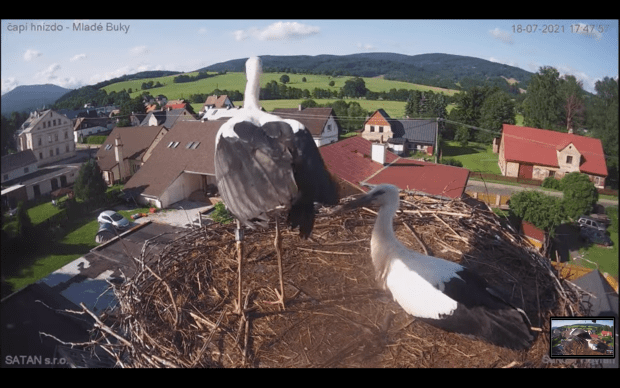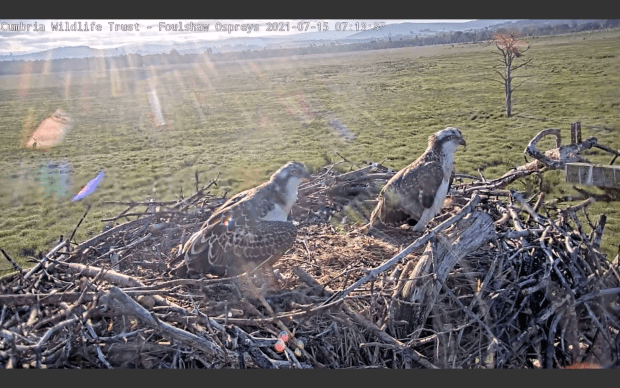There are people with insomnia who are awake and get to see what Tiny aka Little Bob on the Foulshaw Moss Nest in Cumbria is doing. Has she taken another flight? Did she get a fish today? Is she sleeping duckling style? Tiny Little, you have an amazing fan club cheering you on — people from all parts of the world joined together in the adoration of a little osprey that survived and grew into a beautiful fledgling.
Some of us manage to get their first haircut in almost a year and all we want to do is get the wifi password and check in with you! We have your back young lady (or young man).
Today, Tiny Little took her third flight at 18:25:40. You weren’t gone long but you sure looked like you were excited and having some fun when you landed at 18:40:51 on the rim of the nest. You had lost that frightened look of a day or so ago.

You got yourself settled and looked out over your domain. Just look at you! You are gorgeous. It is hard to actually call you Tiny Little or Little Bob anymore since you have grown into a large bird with stout legs, big wings, and the beginnings of what could be a lovely necklace.

You were panting a little bit but you were also looking around as if you wanted to take off again! I bet flying is tiring until you get used to it and build up the strength in those wings. Now all of your aunties and uncles are telling you to do just that – you are going to be on your way to Africa in six weeks and you don’t have a ticket on a commercial airliner. You are your own pilot and navigator.

You were also hungry and hoping that a fish drop would be made. I missed the actual drop but around 19:43 you are on the nest, Tiny Little, and your sibling is tucked into a fish.

One of your admirers told me that you actually had the fish and that big sibling came and took it away. They also told me that you —– yes, you, Tiny Little – stole it back at 20:12. They even sent me a screen capture to prove it. Fantastic Tiny Little!

When I checked on you a few minutes ago, you were sleeping away. But — Tiny Little! You are not sleeping like a duckling! You are standing on the perch like an adult. One more big giant step for you today, Tiny Little.
It looks like all the rays from the moon and stars are shining down on you. By the way, did anyone tell you, Tiny Little, that they want to permanently name that perch after you? What an honour! You have sweet fishy dreams, Tiny Little. We will be waiting to see what you get into tomorrow.

Someone caught Tiny Little’s second flight. You might want to see it again!
In other Osprey news, there was a bit of a giggle over at the Llyn Clywedog Nest in Wales. If you are Only Bob and your dad, Dylan, flies in with a nice Brown Trout and your mom, Seren 5F, flies in with a mullet — which are you going to choose?

Remember. Dylan just loves Brown Trout. He will fly for 25 minutes to and 25 minutes home to get Brown Trout if he can’t get it at the local reservoir. Sometimes Dylan doesn’t like all the fishers down at the end of the reservoir where the trout are so he will travel a distance. Today, it turns out that is a good thing because Only Bob – who already has a huge crop – decided he wants mom’s Mullet. Dad, you get that Brown Trout all to yourself – and you deserve it! Look at the size of this baby of yours.
Do you think Only Bob picked Mom’s mullet because he was certain she would feed him?
The hot weather is also in Wales. The temperature was to be no less than 95 degrees F there today — that is entirely unheard of in the country. That is 35 C. Fingers crossed that there are no casualties.

I was extremely happy to pop into the Collins Marsh Nest in Wisconsin to find that the little chick on the nest was being fed. I am going to assume that there were at least two other meals after this one. Feel free to correct me if you know. I am also hoping that the local temperatures getting cooler after two days of high heat will mean regular fish drops on this nest!
Even before he was finished, the chick has a nice crop. That is very reassuring. Gosh, it wasn’t that long ago when Tiny Little was this small.

I literally just did a quick peek at the Patuxent Osprey Nest 2 to make sure that ‘Silo Chick’ had not fallen out again! I wonder if he knows that he is now known around the world for falling out of two Osprey nests in two days? It must be a record.
This is short. The haircut took the priority today. I almost feel human again.
Thank you so much for joining me. It is always a delight to have you here with us. I also enjoy all of your messages and the news you send. Take care everyone. And for those who asked, I almost forgot. We got even more rain overnight. I do not know if it is helping with the wildfires that are out of control. Many of the Ospreys that come to Manitoba in the summer to breed have their nests in these areas and it is worrisome.
Thank you to the following for their streaming cams where I get my screen shots: Neustadter Nature Center and the Collins Marsh Osprey Nest, Patuxent Park Osprey Nest 2, CarnyX Wild and Llyn Clywedog Osprey Nest, and the Cumbrian Wildlife Trust and the Foulshaw Moss Osprey Nest.






























































































































































